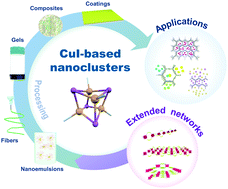Copper(i)–iodide cluster structures as functional and processable platform materials
Abstract
The combination of the copper(I)–iodide entity with organic ligands gives rise to a large variety of CuII polynuclear structures in the form of molecular complexes or extended structures. An appropriate selection of these components allows the preparation of materials showing interesting physicochemical properties and potential applications, mainly focused on organic light-emitting diodes and optical sensors. The most prominent physical feature of these materials is their emission, which can be modulated using the chemical structure and composition. This review article collates the advances in this research field, rationalizing the information into two main blocks as a function of the dimensionality of the structures: molecular complexes and extended networks. We describe the most typical ways of preparation, structures, and properties, with particular attention to the processability of the material as a fundamental aspect of the integration of the materials into real devices. Therefore, we aim to integrate the basic elements of the coordination chemistry of CuII clusters from the materials science perspective to envision this promising research field's potential technological future.



 Please wait while we load your content...
Please wait while we load your content...